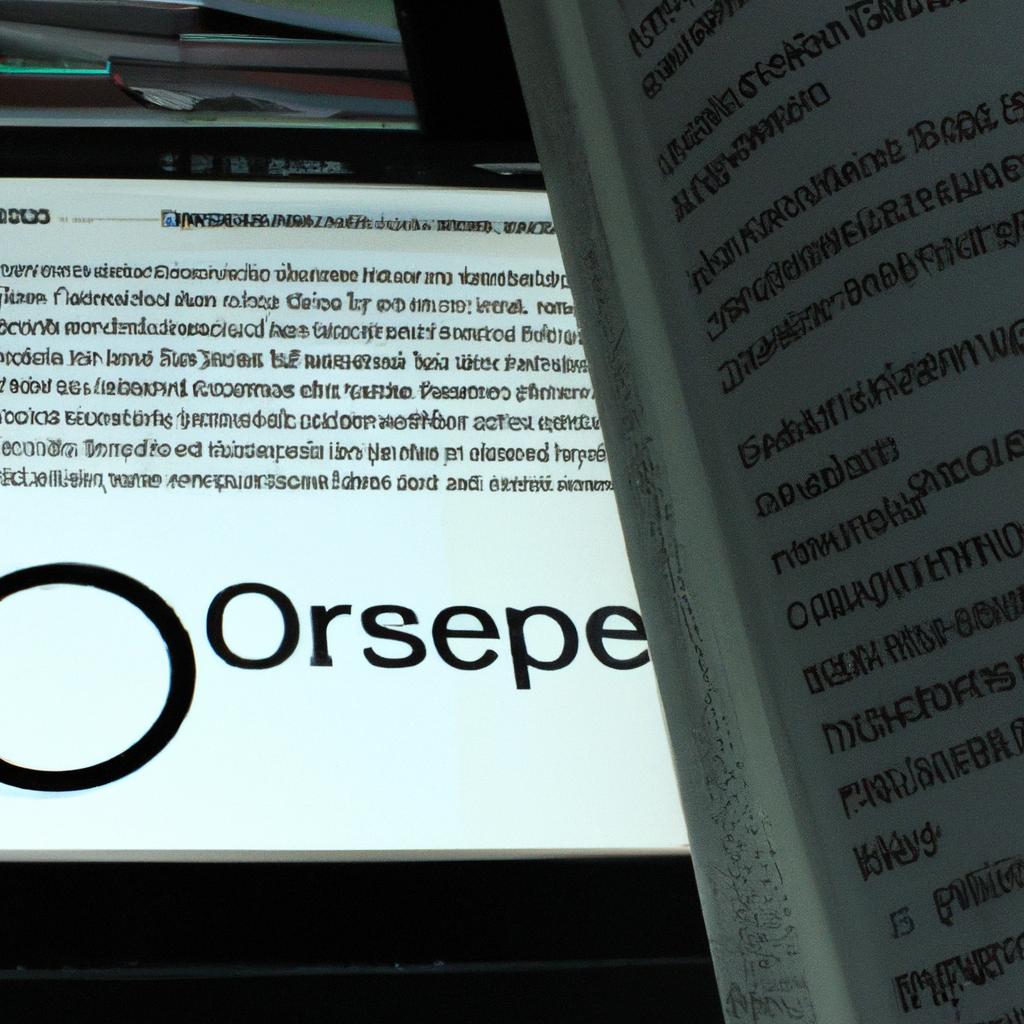Open source software has become an integral part of the modern technological landscape, enabling collaboration and innovation on a global scale. However, navigating the legal complexities surrounding open source licensing can be challenging for individuals and organizations alike. One prominent institution that has made significant contributions to the world of open source software licensing is the Massachusetts Institute of Technology (MIT). This article aims to explore MIT’s role in shaping open source software licensing practices, examining their approach through a case study and providing insights into the broader implications for developers and users.
One compelling example of MIT’s impact on open source software licensing is their involvement in the creation of the widely-used Massachusetts Institute of Technology License (MIT License). The MIT License emerged as a response to the need for a simple yet effective way to share code while maintaining flexibility and allowing for commercial use. By granting users extensive permissions without imposing excessive restrictions, this license strikes a balance between openness and protection. Understanding how MIT spearheaded such innovative licensing solutions sheds light on their commitment to fostering collaborative development environments and promoting knowledge sharing.
In this article, we will delve deeper into MIT’s ethos towards open source software licensing by analyzing their comprehensive guidelines and policies. We will examine key principles underlying these licenses, such as ensuring attribution, limiting liability, and promoting further innovation and collaboration. MIT’s approach to open source licensing emphasizes the importance of giving credit to original authors, while also ensuring that users understand the limitations and potential risks associated with using the software.
Furthermore, this article will explore a case study that exemplifies MIT’s commitment to open source software licensing. We will examine how MIT collaborated with a team of developers to release a groundbreaking software tool under an open source license, facilitating widespread adoption and community-driven improvements. This case study highlights the benefits of embracing open source licensing in terms of scalability, security, and innovation.
Finally, this article will discuss the broader implications of MIT’s contributions to open source software licensing for developers and users alike. By promoting transparent and collaborative development practices, MIT has paved the way for individuals and organizations to leverage open source software for their own projects. The lessons learned from MIT’s approach can empower developers to navigate complex legal landscapes more effectively and encourage a culture of knowledge sharing in the tech community.
In conclusion, this article aims to showcase MIT’s influential role in shaping open source software licensing practices. Through their creation of the widely-used MIT License and their comprehensive guidelines on open source licensing, MIT has demonstrated a commitment to fostering collaboration, innovation, and knowledge sharing in the tech industry. Understanding MIT’s approach can provide valuable insights for developers and users as they navigate the legal complexities surrounding open source software licensing.
MIT and Open Source Software: An Overview
Imagine a group of developers collaborating to create a new software tool that could potentially revolutionize the way we communicate. They pool their expertise, working tirelessly to bring this vision to life. Now, consider how disheartening it would be if someone were to come along, take their creation, and use it for personal gain without contributing back or giving any recognition to its creators. This is where open source software licensing comes into play.
Open source software refers to programs whose source code is made available under a license that allows users to view, modify, and distribute the code freely. One commonly used license in the realm of open source software is the Massachusetts Institute of Technology (MIT) License. The MIT License grants individuals the freedom not only to use and modify the software but also permits them to redistribute it under certain conditions.
To better understand the significance of open source licenses like the MIT License, let’s explore some key points:
- Collaboration: Open source fosters collaboration among developers worldwide who contribute their skills and knowledge towards improving existing projects or creating entirely new ones.
- Transparency: By making the source code accessible, open source encourages transparency and enables others to scrutinize and verify its functionality.
- Flexibility: Developers are free to customize open-source software according to their needs, tailoring it precisely for specific purposes.
- Community-driven Innovation: With an active community behind these projects, ideas flow more freely, leading to innovative solutions with greater potential than those developed by isolated individuals.
Consider this scenario: A team comprising programmers from different countries collaborates on developing a cutting-edge artificial intelligence algorithm using an open-source framework released under the MIT License. Each member brings unique perspectives and expertise while leveraging shared resources provided by other contributors within the community. Their collective efforts result in a powerful solution that can now benefit countless businesses seeking advanced AI capabilities.
| Contributor | Expertise | Country |
|---|---|---|
| John | Machine Learning | USA |
| Maria | Data Analysis | Germany |
| Li | Neural Networks | China |
| Alessandro | Deep Learning | Italy |
In conclusion, open source software licenses such as the MIT License play a crucial role in fostering collaboration, transparency, flexibility, and community-driven innovation. By enabling developers to freely use, modify, and distribute code while protecting their rights, these licenses create an environment where knowledge is shared openly for the betterment of society. Understanding the importance of software licenses sets the stage for exploring how they ensure fairness and promote ethical practices in the digital realm.
Now let’s delve deeper into understanding the importance of software licenses without losing sight of the collaborative nature underlying open source development.
Understanding the Importance of Software Licenses
MIT and Open Source Software Licensing: Explained
In the previous section, we gained an overview of MIT and open source software. Now, let’s delve deeper into the importance of software licenses in this context.
Imagine a scenario where a group of developers collaborates to create a new software application using open source code under the MIT License. This license grants them the freedom to use, modify, distribute, and even sell their derivative work without any restrictions. However, without proper understanding and adherence to licensing terms, complications can arise that may hinder development or lead to legal consequences.
- Licenses ensure transparency: By requiring developers to include license information within their project documentation or code files, users are made aware of their rights and limitations when utilizing the software.
- Protection against liability: Licenses often contain disclaimers that limit the developer’s responsibility for potential damages caused by the software. This protects both creators and end-users from being held liable for unforeseen issues.
- Encouraging collaboration: Clear licensing terms facilitate collaborative efforts as they establish boundaries on how others can contribute to or build upon existing projects.
- Preserving free nature: Open source licenses aim to maintain the ethos of sharing knowledge freely with others while still providing some form of protection for contributors’ intellectual property.
To further illustrate these concepts visually, here is a table showcasing different types of open source licenses along with key characteristics:
| License Type | Key Characteristics |
|---|---|
| MIT License | Permissive; allows commercial usage |
| GNU General Public License (GPL) | Copyleft; requires modifications be distributed under same license |
| Apache License | Balanced approach between permissive and copyleft |
| Creative Commons | Primarily used for non-software creative works |
As we can see from this brief exploration, understanding and complying with open source software licenses is vital for fostering collaboration, protecting creators’ rights, and ensuring the continued growth of the open source community.
Transitioning into the subsequent section about “The MIT License: A Brief History,” it is important to delve deeper into its origins and evolution. Understanding the historical context will provide valuable insights into how this specific license has shaped the landscape of open source licensing as we know it today.
The MIT License: A Brief History
Software licenses play a critical role in governing the use, distribution, and modification of open source software. To further explore this topic, let’s consider an example: Imagine you are a developer who wants to incorporate code from an existing open source project into your own software application. Without proper licensing, utilizing that code could lead to legal complications and potential violations of intellectual property rights.
To navigate these complexities effectively, it is essential to comprehend the significance of software licenses. Here are some key points to keep in mind:
- Protection: Software licenses provide legal protection by clearly defining how others can use or modify your work while ensuring that they do not infringe upon your copyrights.
- Collaboration: By using open source software licenses, developers encourage collaboration within the community. This collaborative environment allows for collective improvement and innovation.
- Freedom: Open source software licenses promote freedom by empowering users to study, modify, distribute, and enhance the original code as per their needs.
- Transparency: Licensing ensures transparency regarding how the software functions and its underlying components.
Let’s delve deeper into these concepts with a closer examination of one popular open source license: The MIT License.
| Key Features | Description |
|---|---|
| Permissive | The MIT License is considered one of the most permissive open source licenses available. It grants users significant freedom to use, modify, and distribute the licensed software without excessive restrictions. |
| Attribution | While the MIT License does not require direct attribution for derivative works or redistributed projects, it encourages acknowledgment through a copyright notice included in relevant files. |
| Liability | The license disclaims any liability associated with damages caused by using or distributing the software unless explicitly stated otherwise – providing protection against potential legal claims related to its usage. |
In summary, understanding software licenses is crucial when working with open source software due to their impact on collaboration, protection, freedom, and transparency. The MIT License is an example of a permissive license that promotes these values while granting users the necessary rights to utilize the licensed software effectively.
[Continue reading: Key Features of the MIT License]
Key Features of the MIT License
Imagine a scenario where a group of developers is working on an open source project. They want to make their code freely available for others to use, modify, and distribute. In this situation, they might consider using the MIT license, which has had a significant impact on the development and growth of open source software.
The MIT license provides certain key features that have made it popular among developers and organizations alike. Firstly, it allows users to freely use, copy, modify, merge, publish, distribute, sublicense or sell copies of the software without any restrictions. This flexibility empowers developers by giving them the freedom to build upon existing projects and create innovative solutions.
Furthermore, the simplicity and permissiveness of the MIT license have contributed significantly to its widespread adoption. Unlike some other licenses that come with complex legal terms and conditions, the MIT license is concise and easy to understand. Its straightforward nature makes it accessible even for those who are not well-versed in legal jargon.
- Encourages collaboration: By allowing unrestricted copying and modification of code, the MIT license promotes collaboration between developers worldwide.
- Fosters innovation: The permissive nature of the license enables developers to experiment with new ideas and contribute back to the community.
- Boosts transparency: With clear guidelines about licensing requirements and distribution rights, the MIT license helps maintain transparency within open source projects.
- Attracts contributors: Many programmers are drawn towards open source projects licensed under the MIT license due to its reputation for being developer-friendly.
In addition to these points, we can further examine how different aspects of open source development have been influenced by incorporating a table:
| Aspect | Influence |
|---|---|
| Code sharing | Encourages sharing and reuse of code without restrictions, fostering collaboration and enabling the rapid development of software solutions. |
| Community building | Facilitates the formation of communities around open source projects, attracting contributors from diverse backgrounds to collaborate on a shared goal. |
| Software quality | Promotes peer review and feedback, resulting in improved software quality through continuous iterations and contributions from multiple developers. |
| Economic implications | Enables commercial use and distribution of open source software, allowing businesses to leverage community-driven innovation while providing value-added services. |
In summary, the MIT license has played a crucial role in shaping the landscape of open source software development. Its simplicity, flexibility, and permissiveness have made it an attractive choice for developers looking to share their work with others freely. The next section will delve into the benefits that open source software brings to various stakeholders across different industries.
Understanding the impact of licenses like the MIT license is essential when considering the numerous advantages that open source software offers in today’s digital age. Let us now explore some key benefits that make open source software an appealing option for individuals, organizations, and society as a whole.
Benefits of Open Source Software
Imagine a scenario where an aspiring software developer, let’s call him Alex, comes across an open-source project on GitHub. Intrigued by its potential and eager to contribute, Alex starts exploring the licensing terms associated with the project. One of the most popular licenses used in the world of open source software is the MIT License. In this section, we will delve deeper into understanding the impact of open source software licensing, focusing specifically on the key features of the MIT License and its benefits.
The MIT License offers developers considerable flexibility and freedom when it comes to using or modifying open-source software. Here are some key features that make this license stand out:
- Permissive: The MIT License allows users to freely use, modify, distribute, sublicense, and sell both original and modified versions of licensed software without imposing significant restrictions.
- Minimalistic: With just 171 words in length (including copyright notice), the MIT License is concise and easy to understand for both legal experts and non-lawyers alike.
- Compatibility: Due to its permissive nature, projects released under the MIT License can be combined with code licensed under other licenses without violating any terms.
- Acknowledgment Requirement: Although not mandatory for compliance with the license itself, many developers choose to include attribution notices within their projects as a sign of recognition for previous contributors.
- Increased collaboration opportunities
- Empowerment through access to high-quality codebase
- Enhanced learning experiences
- Establishing reputation within a vibrant developer community
Additionally, let’s explore a three-column table showcasing specific examples related to each benefit mentioned above:
| Benefit | Example |
|---|---|
| Increased Collaboration | Multiple developers contributing |
| Community-driven support channels | |
| Empowerment through Access | Availability of premium features |
| to High-Quality Codebase | Learning from experienced developers |
| Enhanced Learning Experiences | Active engagement in open-source projects |
| Acquiring new skills and knowledge | |
| Establishing Reputation | Recognition within the developer community |
| within Developer Community | Building a personal portfolio |
Understanding the impact of open source software licensing is crucial for both developers and organizations. It enables innovation, fosters collaboration, and promotes an inclusive environment where individuals can contribute their expertise to create better software solutions. In the subsequent section, we will explore how the MIT License specifically affects developers and why it has become such a popular choice among them.
MIT License and its Impact on Developers
After exploring the benefits of open source software, it is important to understand how licensing plays a crucial role in shaping developer communities. One notable license that has gained widespread adoption is the MIT License. To illustrate its impact, let’s consider a hypothetical scenario: Imagine a group of developers collaborating on an innovative project called “Project X.” Under the MIT License, these developers can freely use, modify, and distribute Project X without any restrictions or fees.
The MIT License offers several key advantages for developers:
- Flexibility: The permissive nature of the MIT License allows developers to incorporate code from Project X into their own projects seamlessly. This flexibility fosters innovation by enabling cross-pollination of ideas and encouraging collaboration within the development community.
- Simplicity: With only 171 words in total, the MIT License is concise and straightforward, making it easy for developers to understand and apply. This simplicity reduces legal complexities and enables faster decision-making processes when choosing licenses for software projects.
- Community-building: By using the MIT License, developers contribute to building vibrant open-source communities where knowledge sharing flourishes. This collaborative environment encourages peer review, feedback loops, and iterative improvements that benefit everyone involved.
- Marketability: Developers who release their work under the MIT License showcase their expertise and commitment to open-source principles. This can enhance professional reputations and attract potential employers or clients seeking individuals with experience working on successful open-source projects.
To further illustrate the significance of licensing choices like the MIT License, we present a table highlighting common attributes of different popular licenses used in open source software development:
| Permissive | Copyleft | Business-friendly | |
|---|---|---|---|
| MIT | Yes | No (weak) | Yes |
| GNU GPL | No | Yes | No |
| Apache 2.0 | Yes | No (strong) | Yes |
This table provides a quick overview of some popular licenses and their characteristics, allowing developers to make informed decisions based on project requirements and personal preferences.
In summary, the MIT License’s permissive nature offers a range of benefits for developers, including flexibility, simplicity, community-building, and marketability. As open-source software continues to shape the technological landscape, understanding licensing choices becomes crucial for building successful projects and contributing effectively to developer communities. By carefully selecting licenses like the MIT License, developers can foster innovation while promoting collaboration and knowledge sharing within the open-source ecosystem.




